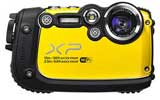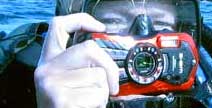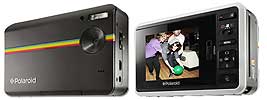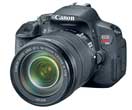Canon pulls out of budget camera market
Wow. Canon apparently decided to get out of the market for budget-priced digital cameras, defined as those under roughly US$200. Instead, Canon will concentrate on their dSLR business and higher end compacts. On the one hand, that decision is understandable, given that every smartphone has integrated cameras that can do most, or more, than dedicated budget compacts can do. On the other hand, the camera industry has brought this upon itself by falling behind the times in the budget class, ignoring advancing technology in storage, technology, connectivity, and software. Another issue was competing against smartphones that are "free" or cost just a few dollars PLUS a 2-year telco contract. -- Posted Monday, February 24, 2014 by chb
Mid-tier camera makers facing hard times
Reuters reports that Japanese mid-tier camera makers Panasonic, Fujifilm, and Olympus are struggling against the tide of camera-equipped smartphones. Compact camera sales are expected to fall more than 40% in 2013 compared to 2012, and the price of those compact had fallen so low that they hardly generated any profit anyway. The photography industry had elected mirror less cameras to catch on, as a way to create higher quality pictures than smartphones can take, but at a lower price than digital SLRs. Yet, mirrorless camera sales have been stalling as well. So for now, the digital camera market that was such a boon since its inception in the late 1990s is in a funk, with only Canon, Nikon and perhaps Sony standing a chance to prevail. [See article] -- Posted Monday, December 30, 2013 by chb
Smartphones to clobber digital camera market
IDC predicts that worldwide sales of digital cameras will fall to 76 million for all of 2013, compared to 118 million in 2012, and a projected 63 million in 2015. The shrinking trend is expected to continue down to just 51 million in 2017. The reason is that smartphones contain ever-better cameras and apps. Our take: It is indeed baffling how digital camera makers stand by with, not recognizing that tiny LCDs and mostly useless features (think toy camera, pet face recognition, silly frames, sepia, etc.) won't do against already very good integrated phone cameras and a flood of terrific, innovative apps. -- Posted Thursday, August 22, 2013 by chb
Nikon ponders impact of smartphones on camera market
Nikon Board Member Makoto Kimura in a recent Q&A on Nikon's future: "it is crucial that we determine how best to adapt our strategies in response to market changes, particularly in terms of new products and product lineups. The rapid penetration of smartphones is causing the compact digital camera market to shrink. Previously, cameras and smart devices were not direct competitors. However, in the current market structure in which these products are competing, we must examine closely the concepts on which our compact digital camera offerings should be based. Thus, when it comes to interchangeable lens-type digital cameras, we need to question our ability to offer truly innovative functions and performance." [See whole Q&A] -- Posted Monday, July 22, 2013 by chb
Olympus profitable again, but compact digital camera sales tanking
Olympus reported it had returned to profitability in fiscal 2012, but its imaging business posted a loss for the third straight year. And with its market for digital cameras rapidly shrinking, Olympus dramatically lowered its 2013 sales target for compact digital cameras to just 2,7 million, down from 5.1 million in 2012. Our take: It's mostly a matter of everyone now having a smartphone with a built-in camera. We always liked Olympus and have done numerous detailed camera reviews for them, but for the past two years they have rejected every one of our requests for review units, so we could not help them spread the word. -- Posted Wednesday, May 15, 2013 by chb
Kodak cameras are available again...
You can now buy Kodak digital cameras again... as long as you don't mind that they come from JK Imaging Ltd., which acquired a global licensing agreement from Kodak under which they can manufacture and sell digital imaging products with the Kodak name. The first product is the Astro Zoom AZ361, a 16mp camera with a 36x (24-864mm) optical zoom, a 3-inch LCD and 720p video. MSRP is US$229. [See the JK Imaging Ltd/Kodak website] -- Posted Friday, April 5, 2013 by chb
Compact digital cameras getting clobbered by smartphones
The conventional digital camera industry has a problem. Seems that digital camera sales in the U.S. will drop more than half from the roughly 38 million in 2011 to an anticipated 18 million this year. Problem is that with smartphones having ever better integrated cameras that can shoot high quality pictures and HD video, and then send and share images and video instantly, there's just not that much of a need to carry around a usually bulkier separate digital camera. Our suggestion to the digital camera industry: concentrate on making compacts that do things smartphones can't. -- Posted Tuesday, April 2, 2013 by chb
Fujifilm introduces rugged freeseproof XP200 camera with wireless, 1080p/60 video and 50 foot depth rating
 With the 16-megapixel FinePix XP200, Fujifilm adds a most impressive offering to the rugged/waterproof camera space. Its 50-foot depth rating makes the camera truly useful for many dives, and is a definite and much appreciated step up from the 33 feet that was the maximum for these types of cameras for several years. And it's freezeproof as well and can handle drops from more than six feet. Add to that 5X optical zoom, 1080p HD video at 60 frames per second, and the ability to wirelessly view and transfer pictures, all for a MSRP of US$299. [See description, analysis and specs of the Fujifilm FinePix XP200] -- Posted Friday, March 22, 2013 by chb With the 16-megapixel FinePix XP200, Fujifilm adds a most impressive offering to the rugged/waterproof camera space. Its 50-foot depth rating makes the camera truly useful for many dives, and is a definite and much appreciated step up from the 33 feet that was the maximum for these types of cameras for several years. And it's freezeproof as well and can handle drops from more than six feet. Add to that 5X optical zoom, 1080p HD video at 60 frames per second, and the ability to wirelessly view and transfer pictures, all for a MSRP of US$299. [See description, analysis and specs of the Fujifilm FinePix XP200] -- Posted Friday, March 22, 2013 by chb
Panasonic technology to double color sensitivity in digital cameras
Panasonic says it has developed a way to dramatically increase color and light sensitivity of digital cameras. Instead of using a simple filter that separates light into a red, green and blue component, blocking more than half of the light, Panasonic proposes separating light via tiny prism-like color splitters into white, red and blue, with no loss of light. It's not clear yet when the new technology will reach products. -- Posted Monday, February 4, 2013 by chb
Ambarella introduces A9 SoC for 4K Ultra HD video
Ambarella, which makes the HD video compression and image processing semiconductors enabling today's tiny sports action cams and numerous other advanced integrated video applications, introduced the A9 camera System-on-Chip (SoC) with support for the new 4K Ultra HD video standard. The A9 enables development of the next generation of mirrorless, sports, and digital still cameras (DSCs) with leading-edge video features and exceptional still image quality. In addition to 4K Ultra HD video, the A9 supports 1080p/120 and 720p/240 video. The A9 uses dual-core ARM Cortex-A9 CPUs and supports wireless connectivity for video streaming or image sharing. [See Ambarella A9 product brief] -- Posted Thursday, January 10, 2013 by chb
Kodak cameras will be back, but...
Soon you'll be able to buy Kodak cameras again, despite Kodak's bankruptcy, but they won't actually be cameras made by Kodak or even commissioned to be made by Kodak. Instead, Kodak sold the right of the Kodak name on cameras to JK Imaging, a subsidiary of a Florida based consumer electronics distributor. There will also be a new Kodak Digital Cameras website here.[See Kodak press release] -- Posted Tuesday, January 8, 2013 by chb
Foxconn buys large stake in GoPro
GoPro announced that Hon Hai Precision Industry Co., Ltd, the world's largest electronics manufacturing company also known as Foxconn, has acquired an 8.88% full-diluted stake in GoPro for US$200 million, valuing the company at US$2.25 billion. Terry Gou, Foxconn's Founder and CEO, will join GoPro's board. Notable products manufactured by Foxconn include Apple's iPhone and iPad, Sony PlayStation, and the Microsoft Xbox. -- Posted Thursday, December 27, 2012 by chb
Sanyo to sell digital camera business
Sanyo is in negotiations to sell its digital camera business to an investment fund by the end of fiscal 2012. With Sanyo's parent, Panasonic, also in the digital camera business, the sale will eliminate overlap within Panasonic. Currently, Sanyo supplies digital cameras to companies such as Olympus Corp. on an original equipment manufacturer basis. [See article] -- Posted Wednesday, November 14, 2012 by chb
Sony and Olympus form alliance
Olympus and Sony announced that they intend to form a business and capital alliance where, among other things, "the two companies also aim to enhance their competitiveness, primarily in the area of compact digital cameras, by exploring opportunities for mutually beneficial transactions and collaboration between their respective camera businesses, including the supply of Olympus technologies such as camera lenses and mirror cells to Sony, and the provision of Sony image sensors to Olympus." [See press release] -- Posted Friday, September 28, 2012 by chb
Four new Polaroid HD camcorders
Consumer electronics manufacturer Sakar International announced one of the world's thinnest and lightest full 1080p HD camcorders as part of a new line of Polaroid-branded digital camcorders. The line includes the ultra-thin iD820, the iD879 with 5x optical zoom, the Wi-Fi enabled iD450 (all three US$179.99), and the rugged and waterproof iD640 (US$99.99). -- Posted Friday, September 21, 2012 by chb
Nikon releases COOLPIX S800 with Android OS
Nikon's just announced COOLPIX S800c combines Nikon's various imaging technologies with built in WiFi and the Android OS to allow for easy operation and sharing of photos and HD video through various social networks. The US$349 S800 has a 16-megapixel CMOS sensor, 10x NIKKOR optical zoom, full1080p HD video, GPS and direct access to Android apps. We're not sure yet how close the S800's Android OS is to what users expect from a standard smartphone, but this is certainly an interesting step. The camera industry tried to create a standard OS once before, a decade ago, and failed. This is different as Android is already the industry-leading smartphone OS. [See Nikon COOLPIX S800] -- Posted Wednesday, August 22, 2012 by chb
Full review: 16MP/1080p Pentax WG-2 can handle 40+ feet
 The Pentax Optio WG-2 represents Pentax's 13th generation of tough, waterproof cameras, and the maturity shows. Sporting a unique design, the 16-megapixel Optio WG-2 has a 40-foot depth rating, can handle 5-foot drops, is freeze and crushproof, can do 1080p HD video at full 30fps speed, has a wide-format 3-inch display, and is chuck-full of features and tricks. ScubaDiverInfo.com tested the US$349 Optio WG-2 on a week of diving and exploring in the Sea of Cortez. [See full review of the Pentax Optio WG-2] -- Posted Thursday, August 2, 2012 by chb The Pentax Optio WG-2 represents Pentax's 13th generation of tough, waterproof cameras, and the maturity shows. Sporting a unique design, the 16-megapixel Optio WG-2 has a 40-foot depth rating, can handle 5-foot drops, is freeze and crushproof, can do 1080p HD video at full 30fps speed, has a wide-format 3-inch display, and is chuck-full of features and tricks. ScubaDiverInfo.com tested the US$349 Optio WG-2 on a week of diving and exploring in the Sea of Cortez. [See full review of the Pentax Optio WG-2] -- Posted Thursday, August 2, 2012 by chb
Full review: The rugged, waterproof Canon PowerShot D20
 Three years ago, Canon introduced its first waterproof compact, the PowerShot D10. It was a good camera, but had a few areas that needed improvement. Canon listened and fixed everything with the PowerShot D20, introduced this year. It's a US$349 12-megapixel camera that is waterproof to 33 feet can handle 5-foot drops, temperature extremes, and can also shoot 1080p HD video. There's a terrific 3-inch screen, good battery life, and logical controls. ScubaDiverInfo.com tested the PowerShot D20 on a week of diving and exploring in the Sea of Cortez. [See full review of the Canon PowerShot D20] -- Posted Thursday, July 26, 2012 by chb Three years ago, Canon introduced its first waterproof compact, the PowerShot D10. It was a good camera, but had a few areas that needed improvement. Canon listened and fixed everything with the PowerShot D20, introduced this year. It's a US$349 12-megapixel camera that is waterproof to 33 feet can handle 5-foot drops, temperature extremes, and can also shoot 1080p HD video. There's a terrific 3-inch screen, good battery life, and logical controls. ScubaDiverInfo.com tested the PowerShot D20 on a week of diving and exploring in the Sea of Cortez. [See full review of the Canon PowerShot D20] -- Posted Thursday, July 26, 2012 by chb
Polaroid Z2300 instant digital camera
 Polaroid announced the Z2300 instant digital camera that combines digital camera technology with instant prints. The 10-megapixel Z2300 camera has a 3-inch LCD, SD card storage, and is able to create 2 x 3 inch instant prints. Available in August 2012, the camera will cost US$159.99. The special ZINK photo paper will run US$15 for a 30-pack. [See Polaroid Z2300] -- Posted Wednesday, June 27, 2012 by chb Polaroid announced the Z2300 instant digital camera that combines digital camera technology with instant prints. The 10-megapixel Z2300 camera has a 3-inch LCD, SD card storage, and is able to create 2 x 3 inch instant prints. Available in August 2012, the camera will cost US$159.99. The special ZINK photo paper will run US$15 for a 30-pack. [See Polaroid Z2300] -- Posted Wednesday, June 27, 2012 by chb
Kodak files for auction of digital imaging patents
Very sad: Eastman Kodak, which filed for bankruptcy in January of 2012, now filed a motion on seeking approval of bidding procedures for bankruptcy auction of its Digital Capture and Kodak imaging Systems and Services patent portfolios, which together comprise more than 1,100 patents. These patents include much of what made today's digital cameras and digital imaging possible. -- Posted Monday, June 11, 2012 by chb
Canon addresses changed user expectation issues with new Rebel 4Ti dSLR
 Canon introduced the Rebel T4i, an 18mp dSLR camera that doesn't look very different from its predecessors (the T2i and T3i), but aims to meet changing user expectations with improved HD video (continuous, silent auto-focus finally), a capacitive 3-inch touch screen, stereo microphones, increased sensitivity, faster continuous shooting (up to 5fps), and much improved autofocus to reduce the annoying "hunting" that plagued earlier models. Retail price for the body alone is US$849, US$949 with a 18-55mm lens, and US$1,199 with a 18-135mm lens. [Read Canon press release] -- Posted Friday, June 8, 2012 by chb Canon introduced the Rebel T4i, an 18mp dSLR camera that doesn't look very different from its predecessors (the T2i and T3i), but aims to meet changing user expectations with improved HD video (continuous, silent auto-focus finally), a capacitive 3-inch touch screen, stereo microphones, increased sensitivity, faster continuous shooting (up to 5fps), and much improved autofocus to reduce the annoying "hunting" that plagued earlier models. Retail price for the body alone is US$849, US$949 with a 18-55mm lens, and US$1,199 with a 18-135mm lens. [Read Canon press release] -- Posted Friday, June 8, 2012 by chb
TechNavio report: Global digital camera market to grow
TechNavio's analysts forecast the Global Digital Camera market to grow at a CAGR of 10% over the period 2011-2015. One of the key factors contributing to this market growth is the increasing demand for digital cameras in emerging markets. The Global Digital Camera market has also been witnessing the availability of user-friendly image processing software. However, the increasing smartphone penetration could pose a challenge to the growth of this market. [Global Digital Camera Market 2011-2015] -- Posted Tuesday, May 15, 2012 by chb
Canon to build cameras without workers
Digital cameras are small and enormously complex, including between 600 and 1,000 pieces. Canon has now announced it is moving towards having entire cameras assembled without any human intervention at all. The first all-robot camera production lines are expected to start in 2015. -- Posted Monday, May 14, 2012 by chb
DCR in Switzerland
The DCR editorial team spent a week in Switzerland, heavily packed with compact cameras, but it's not how taking along cameras used to be. Here's what we took: a Canon G10, a Pentax K2000 dSLR, two GoPro Hero2 in a 3D setup, two iPhone 4s, and two new iPads. What did we use most? Everything! Each device had its particular strengths. The giant screen of the iPads opened whole new vistas and were great for document capture as well, we did 3D video with the GoPros, we used the Pentax for great zoom shots, the workhorse Canon for tons of general shots, and the 360 app on the iPhones to capture those awesome Swiss landscapes. We used the iPhone and iPad cameras much more than anticipated (including Facebook uploads), and they were great to quickly show pictures to local friends. It's a whole new photography world out there! -- Posted Thursday, April 12, 2012 by chb
Olympus to pare camera lineup
Olympus Corp. will pare its lineup of digital camera products in an effort to return its money-losing camera division back to profitability, the company's President-nominee Hiroyuki Sasa said. We hope the mood will help Olympus return to its former glory soon! -- Posted Tuesday, April 3, 2012 by chb
Smartphones increasingly taking the place of point-and-shoots
Bloomberg Businessweek reports that according to IHS digital camera shipments will be down 4.3% this year to 115 million units, the lowest since 2009, while smartphone shipments will be up 35% to 642 million units. What this means is that traditional camera makers will increasingly see the market for dedicated compact cameras diminish. The move away from low-margin, low-priced cameras to dSLRs and higher-end compacts is well underway, of course, but the higher end photography market will always be much smaller than that for quick point-and-shoots. -- Posted Friday, March 16, 2012 by chb
Android on digital cameras?
Engadget reports that Samsung is considering the use of Android in its digital cameras. The idea of using a standard OS and interface in digital cameras, of course, isn't new. A good decade ago a company called Flashpoint tried to convince camera makers to use its standardized Digita operating system. A few tried it (Kodak, Minolta, HP) but Digita failed because the last thing camera makers wanted was to all operate the same. So to this day, every camera works differently, and once you get used to a certain system you're pretty much locked in. So one OS for all cameras is a nice idea, but it would have to provide compelling advantages over all those cobbled-together interfaces we have now. -- Posted Wednesday, March 14, 2012 by chb
Edelman PR refuses review
Edelman PR refuses to let us review Adobe Lightroom. Talk about alienating the media. -- Posted Monday, March 12, 2012 by chb
|











